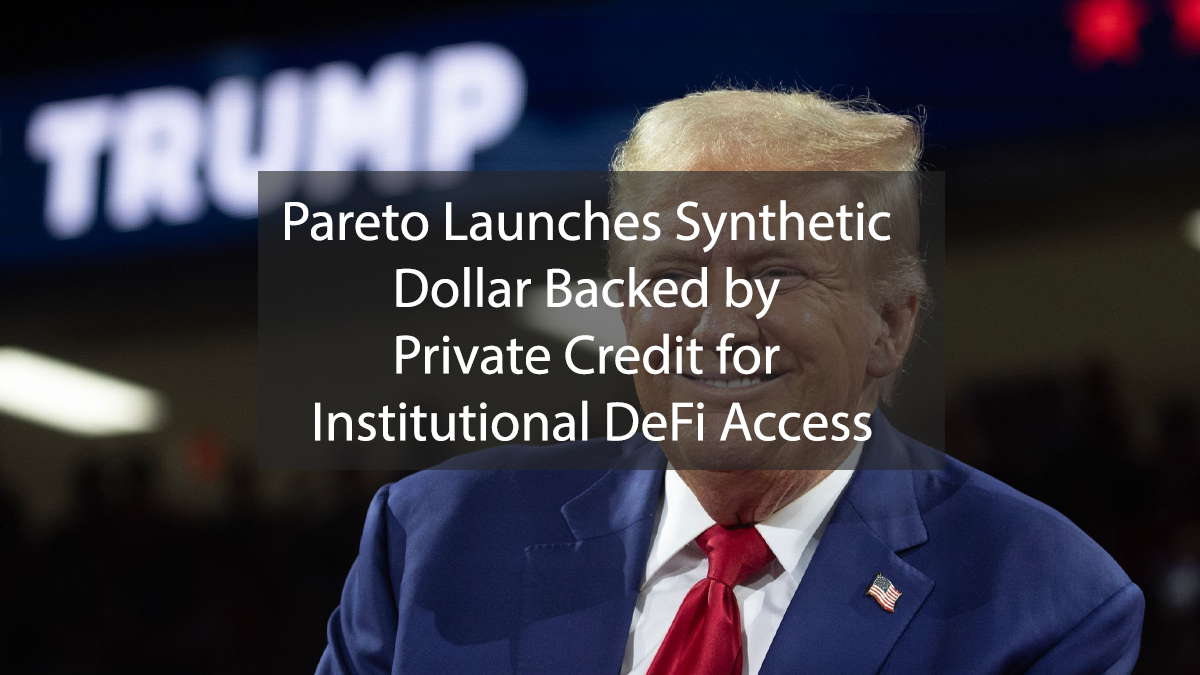
Pareto Launches Synthetic Dollar Backed by Private Credit for Institutional DeFi Access
Pareto, a decentralized private credit marketplace, has just introduced USP, a synthetic dollar designed to revolutionize the way institutions access decentralized finance (DeFi).
Unlike many experimental stablecoins of the past, USP is fully backed 1:1 by USDC and USDT, and these assets are lent through Pareto’s onchain credit vaults to carefully vetted institutional borrowers. It’s a big idea that marries the scale and familiarity of private credit with the speed, transparency, and programmability of blockchain.
But can it succeed where others have stumbled?
What Is USP and How Does It Work?
At its core, USP is a synthetic dollar pegged to the US dollar and created only when stablecoins are deposited into the Pareto ecosystem. Here’s how it works:
- Collateralization: Users mint USP by depositing USDC or USDT.
- Lending: These stablecoins are then lent to institutional borrowers via Pareto’s credit vaults.
- Yield Generation: Depositors earn returns generated from interest on the private credit deals.
- Stability: A protocol-funded stability reserve helps manage risks from borrower defaults.
Pareto uses a “native backing” model to ensure that for every USP in circulation, there’s an equivalent amount of dollar-backed stablecoins behind it. That’s in contrast to other synthetic dollar systems like Ethena’s USDe, which rely on more complex strategies involving derivatives.
“The goal isn’t to replicate TradFi’s weaknesses,” a Pareto spokesperson said, “but to reimagine private credit with the transparency and efficiency of DeFi.”
Why Private Credit Matters Now
Private credit is having a moment.
According to RWA.xyz, the tokenized credit market has surged, with institutional players like Apollo and Tradable experimenting with blockchain-based portfolios.
Pareto joins that momentum with a focus on bringing private credit onchain — unlocking:
- Real-time transparency
- Automated settlement
- Programmable risk management
- Reduced operational friction
These aren’t just technical upgrades; they’re the kind of innovations that could make DeFi attractive to Wall Street.
Institutional Appetite for Yield
With TradFi interest rates staying volatile and bank lending tightening post-pandemic, private credit is filling the gap. And institutions are hunting for yield in a relatively safe but liquid environment.
That’s exactly what Pareto is trying to offer — except with DeFi rails.
Risks and Challenges
While the concept is powerful, it’s not without significant concerns:
| Challenge | Risk Level | Details |
|---|---|---|
| Private Credit Opacity | High | Many traditional credit borrowers remain hard to evaluate transparently. |
| Default Risk | Medium | Pareto has a stability fund, but mass defaults could still destabilize USP. |
| Regulatory Hurdles | High | Stablecoin legislation like the GENIUS Act or STABLE Act could affect collateral frameworks. |
| Arbitrage & Depeg Pressure | Medium | USP’s peg relies on arbitrage incentives — a fragile mechanism during volatility. |
Pareto is betting that onchain audits, smart contracts, and overcollateralization will eliminate these risks — but history hasn’t always been kind to similar synthetic products.
Stablecoins: Now a National Strategic Asset
Zooming out, Pareto’s move reflects a broader shift.
According to Komodo CTO Kadan Stadelmann, stablecoins are now second only to Bitcoin in blockchain utility and adoption. They account for about 1% of the US M2 money supply, which is a staggering figure for a tech born out of the 2008 financial crisis.
In that context, USP isn’t just a DeFi experiment. It’s part of a larger geopolitical and economic narrative, where blockchain-backed dollars could one day rival Treasury bills as safe-haven assets.
And U.S. regulators are waking up to this. As Axelar Protocol’s co-founder Sergey Gorbunov puts it:
“This is about setting the conditions for U.S. financial firms to lead on stablecoins and preserve the dollar’s global primacy.”
Why This Launch Matters
Here’s what makes Pareto’s USP launch a big deal:
- Institutional Onboarding: A new, regulated path into DeFi credit markets
- Yield with Transparency: Better rates than TradFi, with blockchain clarity
- DeFi’s Evolution: Beyond staking and yield farming, toward real economic use
With private credit tokenization expected to reach hundreds of billions, Pareto is positioning USP as a safer, fully collateralized synthetic dollar that appeals to pension funds, endowments, and digital-native treasuries.
Quick Recap
- USP is a fully collateralized synthetic dollar backed by real-world private credit.
- Stablecoins like USDC and USDT back each minted token.
- Funds are lent to vetted institutional borrowers through onchain vaults.
- A stability reserve adds an extra layer of protection against defaults.
- It offers yield and transparency, appealing to institutional capital.
- Part of a broader trend toward tokenized RWAs and dollar-backed DeFi innovation.
FAQs
Is USP a stablecoin or a synthetic asset?
It’s a synthetic dollar, but it behaves like a stablecoin since it is 1:1 backed by USDC and USDT.
What kind of returns can users expect?
Returns come from interest paid by institutional borrowers. Rates will vary by vault and borrower profiles.
Is there risk of depegging?
USP includes an arbitrage mechanism and a stability reserve, but like all synthetic products, market shocks can pose a risk.
Is Pareto regulated?
Pareto is working with institutional-grade borrowers and compliance frameworks but isn’t a licensed bank. Regulation will depend on jurisdiction.
















